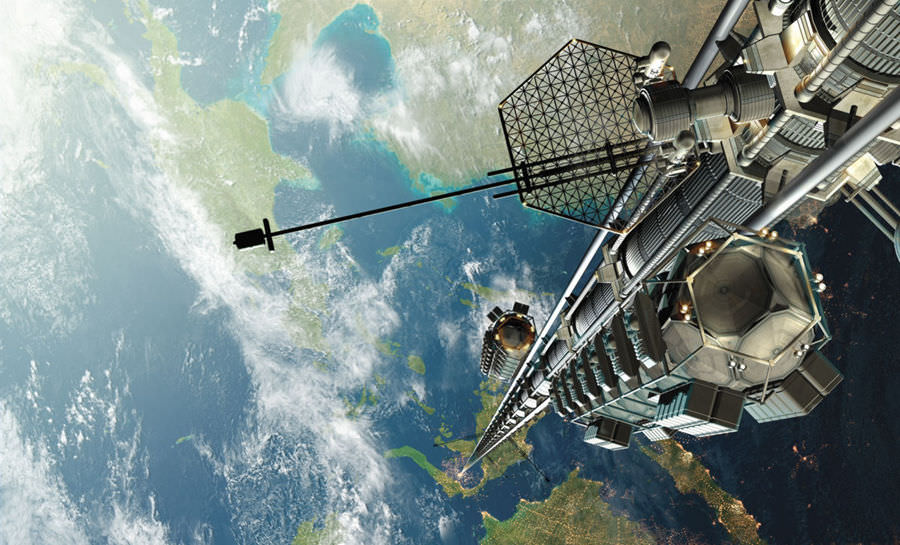Whereas
nanotechnology is too small to be seen, space is much too vast to be perceived entirely.
To put it into perspective, astronomer Carl Sagan has mentioned that “our
planet is a lonely speck in the great enveloping cosmic dark,”[1]. High-rise
buildings and egos may be massive on Earth, but they are nothing in comparison to
the ever-increasing boundaries of the universe.

Carl Sagan's analysis in his book A Pale Blue Dot shows how Earth is small in relation to the universe[1].
Due to
the sheer size of space, it has been a huge domain for artists and scientists
to explore. The Hubble Space Telescope is one innovation that has brought
distant galaxies to our doorsteps. Created
in 1990, this telescope has revealed many mysteries about the universe (age of
the universe, discovery of dark energy, etc.) to scientists[2], but
at the same time, it does so in an artistic way. Many of the images taken from
the Hubble are surprisingly colorful against the black background of space. Moreover,
they showcase the mystical beauty found within nature in the way that the interstellar
clouds produce ghostly projections surrounded by bright lights. The Hubble’s
work is not even done yet as it still continues to take pictures of distant
galaxies to this very day[3].
A video of a 3D image taken from the Hubble Telescope[2].
When
scientists and artists are not looking at the sky for answers, they are writing
and drawing their ideas about how mankind can further explore space. Science
fiction has hugely popularized space exploration in shows such as Star Trek and movies like Star Wars. Books have also played an
important role by inspiring many scientist to make these dreams into reality.
For instance, Arthur C. Clarke’s The
Fountain of Paradise (1976) mentions the idea of a space elevator from
Earth to the moon. This idea has inspired David Smitherman to start plans for
this project in real life using nanotubes and robot climbers[4]. From
these examples, it is possible to see the interconnection between art and
science. Art is helping scientists to imagine the possibilities, while science is
giving artists new insights to work with. Possibly, since space is so large,
there is enough room for artists and scientists to collaborate together.

Conceptual art for what a space elevator might look like[3].
Even
though space can be looked at through a telescope or described in a novel, it
still has ways to go before it can be reached by the general public. An
astronaut alone needs either three years of professional experience or one thousand hours of piloting. This does not even include the other conditions,
which include 20/20 vision and a blood pressure less than 140/90 in sitting
position[5]. These requirements are strict because there have
already been several casualties in space travel such as the Space Challenger
disaster in 1986 and the Columbia incident in 2003[6]. These
tragedies overall paint a grim picture of being trapped inside space shuttle, isolated from the rest of the world. One day, space travel might be safe enough for
everyone, but until then, exploration needs to be left for satellites and
dreams.

The tragedy of the Space Challenger continues to remind people about the dangers in space travel[4].
In the
end, Carl Sagan is right in saying that the universe is huge. However, with some
technology and a little imagination, the vastness of space can be
comprehended and observed by human beings.
Sources:
1. Sagan, Carl. "Pale Blue Dot Quotes." Goodreads. Goodreads Inc., n.d. Web. 22 July 2016. <https://www.goodreads.com/work/quotes/1816628-pale-blue-dot-a-vision-of-the-human-future-in-space>.
2. "Hubble Essentials." Hubble Site. Space Telescope Science Institute (STScI), n.d. Web. 22 July 2016. <http://hubblesite.org/about_us/>.
3. Jäger, Mathias. "Space... The Final Frontier." Hubble Space Telescope. ESA, 21 July 2016. Web. 22 July 2016. <http://www.spacetelescope.org/news/heic1615/>.
4. Vesna, Victoria. "Space Exploration and Art: Part 1." YouTube. uconlineprogram, 29 July 2013. Web. 22 July 2016. <https://www.youtube.com/watch?v=6ZIqTR332l8>.
5. Howell, Elizabeth. "How To Become An Astronaut." Space.com. Purch, 7 May 2014. Web. 22 July 2016. <http://www.space.com/25786-how-to-become-an-astronaut.html>.
6. Vesna, Victoria. "Space Exploration and Art: Part 4." YouTube. uconlineprogram, 30 May 2012. Web. 22 July 2016. <https://www.youtube.com/watch?v=oAZ8bo9T_Pk>.
Images/Videos:
1. Pale Blue Dot. N.d. Pale Blue Dot. Pale Blue Dot. Web. 22 July 2016. <http://palebluedotltd.com/about/>.
2. Flight to Star Cluster Westerlund 2. YouTube. Hubble Space Telescope, 23 Apr. 2015. Web. 22 July 2016. <https://www.youtube.com/watch?v=H5MwOCgzQ6M>.
3. Cain, Fraser. What Is a Space Elevator? Digital image. Universe Today. Fraser Cain, 23 Dec. 2015. Web. 22 July 2016. <http://www.universetoday.com/105441/what-is-a-space-elevator/>.
4. Challenger: The Science of a Space Shuttle Disaster. N.d. Time. Time Inc., 28 Jan. 2016. Web. 22 July 2016. <http://time.com/4196145/space-shuttle-challenger-disaster-science/>.
Sources:
1. Sagan, Carl. "Pale Blue Dot Quotes." Goodreads. Goodreads Inc., n.d. Web. 22 July 2016. <https://www.goodreads.com/work/quotes/1816628-pale-blue-dot-a-vision-of-the-human-future-in-space>.
2. "Hubble Essentials." Hubble Site. Space Telescope Science Institute (STScI), n.d. Web. 22 July 2016. <http://hubblesite.org/about_us/>.
3. Jäger, Mathias. "Space... The Final Frontier." Hubble Space Telescope. ESA, 21 July 2016. Web. 22 July 2016. <http://www.spacetelescope.org/news/heic1615/>.
4. Vesna, Victoria. "Space Exploration and Art: Part 1." YouTube. uconlineprogram, 29 July 2013. Web. 22 July 2016. <https://www.youtube.com/watch?v=6ZIqTR332l8>.
5. Howell, Elizabeth. "How To Become An Astronaut." Space.com. Purch, 7 May 2014. Web. 22 July 2016. <http://www.space.com/25786-how-to-become-an-astronaut.html>.
6. Vesna, Victoria. "Space Exploration and Art: Part 4." YouTube. uconlineprogram, 30 May 2012. Web. 22 July 2016. <https://www.youtube.com/watch?v=oAZ8bo9T_Pk>.
Images/Videos:
1. Pale Blue Dot. N.d. Pale Blue Dot. Pale Blue Dot. Web. 22 July 2016. <http://palebluedotltd.com/about/>.
2. Flight to Star Cluster Westerlund 2. YouTube. Hubble Space Telescope, 23 Apr. 2015. Web. 22 July 2016. <https://www.youtube.com/watch?v=H5MwOCgzQ6M>.
3. Cain, Fraser. What Is a Space Elevator? Digital image. Universe Today. Fraser Cain, 23 Dec. 2015. Web. 22 July 2016. <http://www.universetoday.com/105441/what-is-a-space-elevator/>.
4. Challenger: The Science of a Space Shuttle Disaster. N.d. Time. Time Inc., 28 Jan. 2016. Web. 22 July 2016. <http://time.com/4196145/space-shuttle-challenger-disaster-science/>.
No comments:
Post a Comment